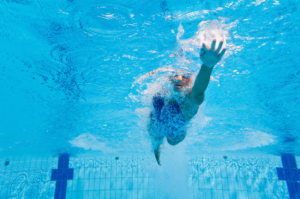Are you looking to enhance your swimming skills and leave your competition in the dust? If so, you’re not alone. Many swimmers strive to swim faster, but often find themselves struggling to make significant progress.
The key to unlocking your full potential lies in a combination of technique and efficiency. In this comprehensive guide, we will explore the essential principles and strategies that will help you swim faster and achieve your goals in the water.
Train Smarter, not Harder
When it comes to improving your swimming speed, many coaches focus primarily on physical conditioning. While building strength and endurance is important, it is equally crucial to address any deficiencies in your technique. Swimming efficiently requires mastering proper stroke mechanics and reducing drag in the water. By adopting a two-pronged approach that emphasizes technique improvement and increased propulsion, you can take your swimming performance to new heights.
Decreasing Drag: The First Step to Faster Swimming
Water is denser than air, and as a result, the drag you create in the water can significantly impact your speed. To swim faster, it is essential to minimize drag by focusing on the following principles:
Principle #1: Improving Your Balance
Maintaining a good horizontal balance is crucial for reducing drag in the water. When swimming freestyle, for example, it is important to keep your body as horizontal as possible. Avoid lifting your head forward before turning it to breathe, as this can disrupt your balance and cause your hips and legs to sink. By staying streamlined and balanced, you can minimize drag and move through the water more efficiently.
Principle #2: Swimming Taller
To further decrease drag, aim to swim as tall as possible in the water. By extending your recovering arm forward underwater and fully extending it before starting the downsweep and catch, you can create a more streamlined profile. This “swimming taller” technique ensures that you move through the water with minimal resistance, allowing you to swim faster and more efficiently.
Principle #3: Compact and Efficient Kick
While the kick is not the primary source of propulsion in swimming, it still plays a role in overall speed. To improve your kick, focus on performing fast and compact kicking movements. Keep your feet slightly below the water surface, avoiding excessive movement below the body line. By using a fast and efficient kick, you can reduce drag and enhance your swimming speed.
Improving Propulsion: Unleashing Your Power in the Water
Once you have minimized drag, it’s time to focus on maximizing your propulsion. By improving the mechanics of your stroke, you can generate more power and swim faster. Consider the following principles:
Principle #4: Swim More on the Sides
To enhance your propulsion, incorporate more rotational movement into your stroke. Rolling sufficiently from side to side with each arm pull allows you to engage not only your shoulder muscles but also your chest and back muscles. This increased engagement of the larger muscle groups amplifies your power in the water, enabling you to swim faster. While swimming on your sides may feel unfamiliar at first, with practice, it will become a natural and effective technique.
Principle #5: Using Your Core Muscles
Engaging your core muscles is crucial for generating power in your stroke and maintaining endurance. The synergy between your core, back, shoulder, and chest muscles allows you to exert energy without tiring your shoulders too quickly. Imagine the motion of a baseball pitcher throwing a ball, where the energy starts from the core and transfers through the upper body into the arm. By integrating this technique into your swimming, you can swim longer, faster, and with greater efficiency.
Principle #6: Anchoring Your Arms
Anchoring your arms in the water is essential for maximizing propulsion. Before pulling your arm backward, ensure that your forearm and hand are in line and pointing downward, with the inside of your forearm and palm facing backward. This technique, known as the high-elbow catch, allows you to generate significant propulsion as you move your arm backward as a single unit. By mastering this technique, you can unleash the power of your arms and swim faster than ever before.
Minimize Resistance: Streamlining Your Path to Speed
To swim faster, it’s crucial to minimize resistance and maintain a streamlined position as you move through the water. By focusing on the following principles, you can reduce unnecessary drag and increase your speed:
Principle #7: Move the Spine Straight Through the Water
Keeping your spine as straight as possible is crucial for minimizing resistance and maximizing speed. Just like a smooth hull of a ship, a straight spine allows you to move through the water with minimal turbulence. Avoid excessive bending, arching, or swaying motions that can create unnecessary drag. By paying attention to the alignment of your spine, you can optimize your body position and swim faster.
Principle #8: Minimize the Impact of Breathing on Body Line
Breathing can significantly impact your body position and create resistance in the water. Avoid breathing too high, which can cause your hips to sink, or pulling your head too far to the side, which can lead to a sideways bend in your body. Find ways to “hide” your breath and breathe without excessive lateral or vertical movement. By minimizing the impact of breathing on your body line, you can maintain a streamlined position and swim faster.
Principle #9: Minimize the Impact of Arm Recoveries on Body Line
The way you recover your arms during the stroke can also impact your body position and resistance in the water. Avoid swinging your arms too far out to the side or lifting them high out of the water, as these movements can disrupt your streamline and slow you down. Strive for symmetrical arm recoveries and pay attention to how they affect your overall swimming technique. By minimizing the impact of arm recoveries on your body line, you can move through the water more efficiently and increase your speed.
Swim With Great Timing: The Key to Effortless Speed
To achieve effortless speed in the water, mastering stroke timing, rhythm, and coordination is essential. By understanding and implementing proper timing techniques, you can optimize your swimming performance. Consider the following principles:
Principle #10: Rotational Timing
For long-axis strokes such as freestyle and backstroke, rotational timing is crucial. Ensure that your rotation is timed with your hand entry into the water. As your hand drives into the water, your shoulders should reach the end point of their rotation. This synchronized rotation allows for efficient power transfer and propels you forward. Pay attention to the timing of your rotations and make adjustments to achieve optimal performance.
Principle #11: Undulation Timing
In short-axis strokes like breaststroke and butterfly, undulation timing is vital. Focus on achieving the right amount of undulation, with the peak of the undulation occurring when you breathe. The bottom of the undulation should coincide with the extension of your arms in front, allowing for a smooth and efficient movement through the water. By mastering the timing of undulation, you can enhance your stroke rhythm and swim faster.
Principle #12: Kick Timing
Proper timing between your arms and legs is crucial for breaststroke, butterfly, and freestyle. Strive for coordination and synergy between your limbs, ensuring they work together rather than against each other. Pay attention to the timing of your arm strokes and leg kicks, making adjustments as needed to optimize your performance in the water.
Principle #13: Breath Timing
Timing your breath is essential for maintaining body position and stroke rate. Avoid breathing too early, as it may be challenging to lift your head out of the water in time. Additionally, breathing late can disrupt your stroke rhythm and slow you down. Find a balance and ensure that you can smoothly transition from breathing back into the water. By mastering breath timing, you can maintain efficiency and swim faster.
Put It All Together: Achieving Your Full Potential in the Water
To swim faster, you must combine the principles of maximizing propulsion, minimizing resistance, and swimming with great timing. By integrating these techniques into your training and practice sessions, you can unlock your full potential in the water. Remember, learning how to swim faster is a journey that requires dedication and perseverance.




